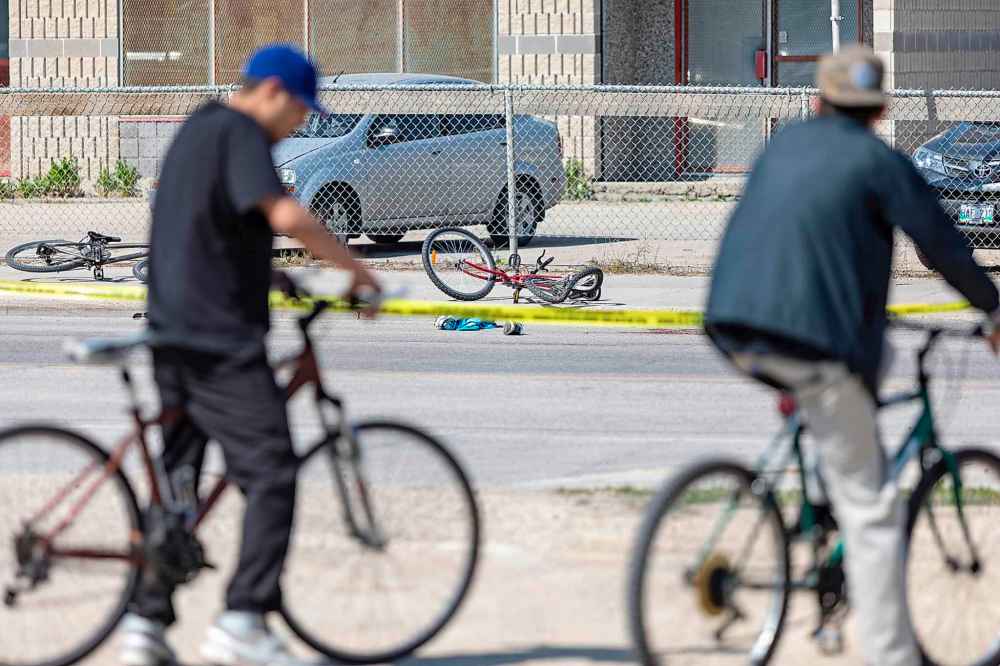Pedestrian scrambles on road safety strategy to-do list
Read this article for free:
or
Already have an account? Log in here »
To continue reading, please subscribe:
Monthly Digital Subscription
$19 $0 for the first 4 weeks*
- Enjoy unlimited reading on winnipegfreepress.com
- Read the E-Edition, our digital replica newspaper
- Access News Break, our award-winning app
- Play interactive puzzles
*No charge for 4 weeks then billed as $19 every four weeks (new subscribers and qualified returning subscribers only). Cancel anytime.
Read unlimited articles for free today:
or
Already have an account? Log in here »
Hey there, time traveller!
This article was published 11/09/2019 (1688 days ago), so information in it may no longer be current.
Pedestrian scrambles — intersections where traffic is stopped in all directions to allow people to cross any way, including diagonally — will make Winnipeg streets safer, city traffic engineers say.
The traffic measure, used in cities with heavy foot traffic including Banff, Alta., and Toronto, is one of several being undertaken by the City of Winnipeg as part of its road safety strategy.
“We think this will have an effect on removing the conflict between pedestrians and motorists,” David Patman, manager of transportation in the public works department, said during a committee meeting Thursday.

Patman told the public works committee his department has short-listed a number of intersections believed to be good matches for a scramble.
The city has yet to make location details public, nor has it provided a timeline for the completion of such projects. However, Patman said short-term engineering safety projects are changes that can be made “right away.”
The costs will be covered by the city’s $2.5-million budget for road safety measures in 2019.
Pedestrian scrambles aside, Patman said Thursday his team wants to divvy up funds for strategic planning, data collection, public engagement campaigns, and other engineering projects.
The funds will cover the costs of installing more cameras to monitor safety hazards at “high-priority” intersections, as well as new flashing countdowns at crosswalks and protected left-turn lanes.
“At many locations in the city, when you want to do a left turn, you sit in the intersection at the green phase and you wait for a gap. This can be very frustrating when there’s very few gaps in the traffic and people get frustrated.”– David Patman, manager of transportation in the public works department
“At many locations in the city, when you want to do a left turn, you sit in the intersection at the green phase and you wait for a gap,” Patman said. “This can be very frustrating when there’s very few gaps in the traffic and people get frustrated. They’ve got people behind them that are sort of glaring at them, they can see in their rear-view mirror that they want them to go, they start honking (horns), and people start taking chances.”
The budget, he added, will also cover a request for proposal that seeks to develop a five-years-and-beyond plan to assess road safety in the city. It would expand on the Manitoba Road Safety Plan, which expires in 2020. The deadline for applications for the $275,000 contract is Oct. 8.
The city’s road safety has been put under scrutiny this year; a total of nine pedestrians and one cyclist have died in Winnipeg in 2019.
In 2017, the city started actively working towards adopting the principles of Towards Zero (fatalities), a national traffic safety approach that recognizes pedestrian deaths are preventable and driver error is unavoidable, meaning infrastructure must be forgiving of that.

Of the total Winnipeg collisions reported in 2012-15 — the latest traffic data compiled over a four-year period — less than 0.1 per cent resulted in a fatality, while about 0.3 per cent resulted in a major injury. About 36 per cent of the fatal collisions involved a pedestrian.
The cause of 40 per cent of those fatal pedestrian collisions is unknown. A pedestrian crossing with the right of way or running onto a roadway resulted in some of the deaths (18 per cent and 17 per cent, respectively).
Fatalities that involved a pedestrian walking along a roadway against traffic, at an intersection without the right of way or on a sidewalk, median or safety zone each accounted for six per cent of the total count.
“If you have 90 seconds of red (lights) every direction, you’re going to move less traffic, but you’re going to move more pedestrians more safely because they can cross at all points.”– Todd Dube, founder of motor and traffic advocacy group Wise Up Winnipeg
The city’s latest report on collisions also shows streets with 60-km/h speed limits are overrepresented in fatal and major collisions, followed by 80-km/h areas.
Todd Dube, founder of motor and traffic advocacy group Wise Up Winnipeg, said he supports the city’s pedestrian scramble idea — even though it might cause more congestion for vehicles in the downtown core.
“If you have 90 seconds of red (lights) every direction, you’re going to move less traffic, but you’re going to move more pedestrians more safely because they can cross at all points,” he said.
Dube said the first ideal intersection that comes to mind is Portage Avenue and Memorial Boulevard, outside the University of Winnipeg.
maggie.macintosh@freepress.mb.ca
Twitter: @macintoshmaggie

Maggie Macintosh
Reporter
Maggie Macintosh reports on education for the Winnipeg Free Press. Funding for the Free Press education reporter comes from the Government of Canada through the Local Journalism Initiative.










